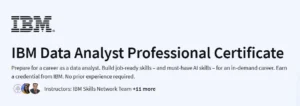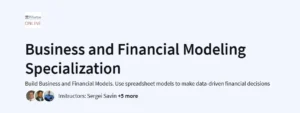What will you learn in this Introduction to Data Science in Python Course
Understand fundamental Python programming techniques, including functions, sequences, and working with CSV files.
Utilize Python libraries such as NumPy and pandas for data manipulation and analysis.
Perform data cleaning, transformation, and analysis using pandas DataFrames.
Apply basic statistical concepts, including distributions, sampling, and t-tests, to real-world data.
Program Overview
1. Fundamentals of Data Manipulation with Python
⏳ 13 hours
Introduction to Python programming, covering functions, sequences, reading and writing CSV files, and an overview of NumPy.
2. Introduction to pandas
⏳ 7 hours
Learn the basics of the pandas library, including Series and DataFrame objects, and perform data selection and filtering.
3. Data Wrangling with pandas
⏳ 7 hours
Delve into data cleaning and transformation techniques, such as handling missing data, merging datasets, and reshaping DataFrames.
4. Basic Data Analysis with pandas
⏳ 7 hours
Apply statistical methods to analyze data, including grouping, pivot tables, and conducting t-tests for hypothesis testing.
Get certificate
Job Outlook
Equips learners for roles such as Data Analyst, Data Scientist, and Business Analyst.
Applicable in industries like technology, finance, healthcare, and e-commerce.
Enhances employability by providing practical skills in data analysis and statistical reasoning.
Supports career advancement in fields requiring expertise in data-driven decision-making.
Specification: Introduction to Data Science in Python
|
FAQs
- Basic Python knowledge is recommended.
- Understanding variables, loops, and functions helps.
- Absolute beginners may need additional study to follow assignments.
- Familiarity with CSV and basic data structures improves learning.
- The course gradually introduces libraries like pandas and NumPy for hands-on practice.
- Provides foundational skills for roles like Data Analyst or Business Analyst.
- Teaches data cleaning, analysis, and visualization using Python.
- Introduces basic statistical concepts for real-world data interpretation.
- Hands-on projects reinforce practical, employable skills.
- Supports transition into technology, finance, healthcare, and e-commerce sectors.
Students often worry about math prerequisites in a data science course.
- Self-paced learning allows flexible scheduling.
- Total course duration (~34 hours) can be spread over weeks.
- Assignments and exercises can be completed incrementally.
- Lifetime access enables review and reinforcement anytime.
- Ideal for professionals aiming to upskill without leaving work.
- Certificate of completion is provided after finishing all modules.
- Issued by the University of Michigan via the course platform.
- Shareable on LinkedIn and other professional profiles.
- Demonstrates practical Python and data analysis skills to employers.
- Enhances employability but is not a formal academic degree.





